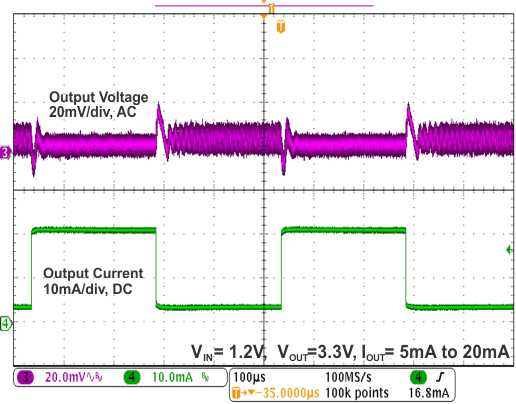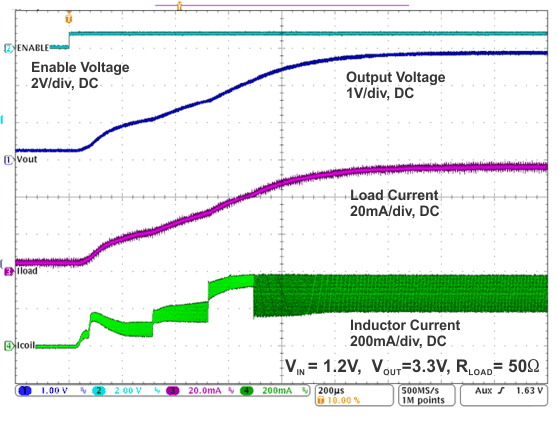SLVSB53A May 2012 – December 2014 TLV61220
PRODUCTION DATA.
- 1 Features
- 2 Applications
- 3 Description
- 4 Typical Application Schematic
- 5 Revision History
- 6 Device Options
- 7 Pin Configuration and Functions
- 8 Specifications
- 9 Parameter Measurement Information
- 10Detailed Description
- 11Application and Implementation
- 12Power Supply Recommendations
- 13Layout
- 14Device and Documentation Support
- 15Mechanical, Packaging, and Orderable Information
Package Options
Mechanical Data (Package|Pins)
- DBV|6
Thermal pad, mechanical data (Package|Pins)
Orderable Information
11 Application and Implementation
NOTE
Information in the following applications sections is not part of the TI component specification, and TI does not warrant its accuracy or completeness. TI’s customers are responsible for determining suitability of components for their purposes. Customers should validate and test their design implementation to confirm system functionality.
11.1 Application Information
The TLV61220 is intended for systems powered by a single cell battery to up to three Alkaline, NiCd or NiMH cells with a typical terminal voltage between 0.7 V and 5.5 V. It can also be used in systems powered by one-cell Li-Ion or Li-Polymer batteries with a typical voltage between 2.5 V and 4.2 V. Additionally, any other voltage source with a typical output voltage between 0.7 V and 5.5 V can be used with the TLV61220.
11.2 Typical Application
![TLV61220 Typical Application Circuit
for Adjustable Output Voltage Option TLV61220 pmi_schem776rev3[1].gif](/ods/images/SLVSB53A/pmi_schem776rev3[1].gif) Figure 14. Typical Application Circuit for Adjustable Output Voltage Option
Figure 14. Typical Application Circuit for Adjustable Output Voltage Option
11.2.1 Design Requirements
In this example, TLV61220 is used to design a 3.3-V power supply with up to 50-mA output current capability. The TLV61220 can be powered by a single-cell battery to up to three Alkaline, NiCd or NiMH cells with a typical terminal voltage between 0.7 V and 5.5 V. It can also be used in systems powered by one-cell Li-Ion or Li-Polymer batteries with a typical voltage between 2.5 V and 4.2 V. In this example, the input voltage range is from 2 V to 3 V for one-cell coin cell battery input design.
Table 2. TLV61220 3.3 V Output Design Requirements
| PARAMETERS | VALUES |
|---|---|
| Input Voltage | 2 V to 3 V |
| Output Voltage | 3.3 V |
| Output Current | 50 mA |
11.2.2 Detailed Design Procedure
Table 3. List of Components
| COMPONENT REFERENCE | PART NUMBER | MANUFACTURER | VALUE | |
|---|---|---|---|---|
| C1 | GRM188R60J106ME84D | Murata | 10 μF, 6.3V. X5R Ceramic | |
| C2 | GRM188R60J106ME84D | Murata | 10 μF, 6.3V. X5R Ceramic | |
| L1 | 1269AS-H-4ZR7N | Toko | 4.7 μH | |
| R1, R2 | R1= 1MΩ, R2= Values depending on the programmed output voltage | |||
11.2.2.1 Adjustable Output Voltage Version
An external resistor divider is used to adjust the output voltage. The resistor divider needs to be connected between VOUT, FB and GND as shown in Figure 14. When the output voltage is regulated properly, the typical voltage value at the FB pin is 500 mV. The maximum recommended value for the output voltage is 5.5 V. The current through the resistive divider should be about 100 times greater than the current into the FB pin. The typical current into the FB pin is 0.01 μA, and the voltage across the resistor between FB and GND, R2, is typically 500 mV. Based on those two values, the recommended value for R2 should be lower than 500 kΩ, in order to set the divider current to 1 μA or higher. The value of the resistor connected between VOUT and FB, R1, depending on the needed output voltage (VOUT), can be calculated using Equation 1:

As an example, if an output voltage of 3.3 V is needed, a 1-MΩ resistor is calculated for R1 when for R2 a 180-kΩ has been selected.
11.2.2.2 Inductor Selection
To make sure that the TLV61220 can operate, a suitable inductor must be connected between pin VBAT and pin SW. Inductor values of 4.7 μH show good performance over the whole input and output voltage range .
Choosing other inductance values affects the switching frequency f proportional to 1/L as shown in Equation 2.

Choosing inductor values higher than 4.7 μH can improve efficiency due to reduced switching frequency and, therefore, with reduced switching losses. Using inductor values below 2.2 μH is not recommended.
Having selected an inductance value, the peak current for the inductor in steady state operation can be calculated. Equation 3 gives the peak current estimate.

For selecting the inductor this would be the suitable value for the current rating. It also needs to be taken into account that load transients and error conditions may cause higher inductor currents.
Equation 4 helps to estimate whether the device will work in continuous or discontinuous operation depending on the operating points. As long as the inequation is true, continuous operation is typically established. If the inequation becomes false, discontinous operation is typically established.

The following inductor series from different suppliers have been used with TLV61220 converters:
Table 4. List of Inductors
| VENDOR | INDUCTOR SERIES |
|---|---|
| Toko | DFE252010C |
| Coilcraft | EPL3015 |
| EPL2010 | |
| Murata | LQH3NP |
| Taiyo Yuden | NR3015 |
| Wurth Elektronik | WE-TPC Typ S |
11.2.2.3 Capacitor Selection
11.2.2.3.1 Input Capacitor
At least a 10-μF input capacitor is recommended to improve transient behavior of the regulator and EMI behavior of the total power supply circuit. A ceramic capacitor placed as close as possible to the VBAT and GND pins of the IC is recommended.
11.2.2.3.2 Output Capacitor
For the output capacitor C2, it is recommended to use small ceramic capacitors placed as close as possible to the VOUT and GND pins of the IC. If, for any reason, the application requires the use of large capacitors which can not be placed close to the IC, the use of a small ceramic capacitor with an capacitance value of around 2.2μF in parallel to the large one is recommended. This small capacitor should be placed as close as possible to the VOUT and GND pins of the IC.
A minimum capacitance value of 4.7 μF should be used, 10 μF are recommended. If the inductor value exceeds 4.7 μH, the value of the output capacitance value needs to be half the inductance value or higher for stability reasons, see Equation 5.

The TLV61220 is not sensitive to the ESR in terms of stability. Using low ESR capacitors, such as ceramic capacitors, is recommended anyway to minimize output voltage ripple. If heavy load changes are expected, the output capacitor value should be increased to avoid output voltage drops during fast load transients.
11.2.3 Application Curves
| FIGURE | |
|---|---|
| Load transient, VI = 1.2 V, VO = 3.3 V, IO = 5mA to 20 mA | Figure 15 |
| Line transient, VI = 1.8 V to 2.4V, VO = 3.3 V, IO = 30 mA | Figure 16 |
| Startup after Enable, VI = 1.2 V, VO = 3.3 V, RLOAD = 50 Ω | Figure 17 |
spacing
 Figure 15. Load Transient Response
Figure 15. Load Transient Response
 Figure 17. Start Up After Enable
Figure 17. Start Up After Enable
 Figure 16. Line Transient Response
Figure 16. Line Transient Response